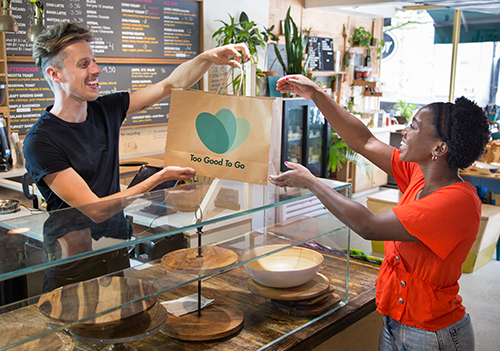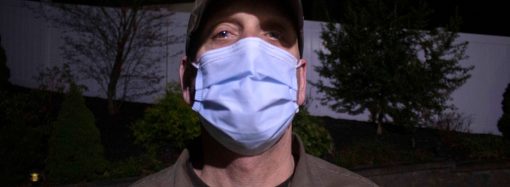By Deidre Redhead
It’s the most wasteful time of the year.
The holiday season is traditionally synonymous with preparing large quantities of food. And while Thanksgiving and any upcoming Christmas celebrations may be digital and downsized for this year, the amount of food that gets leftover and wasted isn’t likely to be much different.
At Thanksgiving, approximately 200 million pounds of turkey gets thrown away. Thirty million pounds of gravy gets poured out. Fourteen million pounds of dinner rolls are dumped.
Between Thanksgiving and New Year’s, an estimated extra 25% of food waste gets generated according to the Environmental Protection Agency.
Food waste isn’t just a seasonal issue, however. The EPA has also found that Americans waste approximately 40 million tons of food every year. Food and environmental science organizations have been at the forefront for food sustainability, but food waste apps are emerging as another solution.
The app Too Good To Go has been helping cut food waste in Europe since launching in Denmark in 2016. This year, the app had its U.S. debut, setting up shop in the most wasteful city in the world: New York City.
The app launched in the city on Sept. 29, coinciding with the International Day of Awareness of Food Loss and Waste, designated by the United Nations General Assembly. More than 250 local businesses across the city have partnered with the app.
Too Good to Go provides restaurant owners with the opportunity to help reduce food waste.
The app connects customers to nearby cafes, bakeries and restaurants in their area that are selling the remainder of their food at the end of the day for a third of the original price.
Settepani Bakery is one of Too Good to Go’s partners. Its original Williamsburg location sells about two packages a day. At its Harlem location, up to four packages are reserved, sold and picked up through the app.
“I have people coming in on a regular basis at 6 p.m. when we close,” said Antonino Settepani, the owner of Settepani Bakery in Williamsburg, Brooklyn. “It’s very, very seamless.”
Settepani said the easy interaction that comes with the technology of apps like Too Good to Go has also prevented participants from feeling embarrassed about taking leftovers.
Many people feel reluctant to ask for takeout or to-go boxes at the end of a meal because they fear doing so may reflect poorly on them.
The debate dates back to the 1960s when etiquette columns would frequently discuss the respectability of taking home food from restaurants. Emily Post, author and newspaper columnist, once wrote in an 1968 column that “Restaurants provide ‘doggy bags’ for bones to be taken to pets, and generally the bags should be restricted to that use.”
Picking up the leftover food with no questions asked, Settepani said, has helped customers become more comfortable tackling a societal stigma.
“Sometimes, there’s a sense of shame,” he said. “We don’t have to say anything to them, they don’t have to say anything to us. I don’t want to embarrass them.”
Restaurants and caterers make up only 20% of the food waste generated in New York City, according to an October 2017 report by the National Resources Defense Council. Some 54% of food waste came from residential settings.
Too Good to Go isn’t the first app to tackle food waste. Olio and Food for All, founded in 2015 and 2017 respectively, have also contributed to reducing restaurant waste. But instead of customers selecting the items that nearby restaurants have listed, as these apps permit, restaurants using Too Good to Go handpick the remaining goods to put in takeout boxes called “Surprise Bags.”
The surprise element can be an exciting concept. But for Juliet DeMarco, it has its disadvantages. DeMarco lives with a roommate, and when she first used the app, the “Surprise Bag” held more food than the two of them could use.
“We barely needed this giant bag of pastries,” she said. “I felt bad because we’re going to end up wasting this.”
New York City households waste about 8.4 pounds of food per week on average, according to the NRDC. Even edible food gets thrown out, totaling about 5.4 pounds weekly. The amount of food waste consumers generate, as well as restaurants, DeMarco said, speaks volumes on how much food waste the city makes and how much work still needs to be done.
“Even if you’re giving it away, at the end of the day there’s still food going to waste,” she said. “It kind of feels like a drop in the bucket. So there’s still the bigger issue of, like, how do you distribute resources correctly?”
Food waste is a worldwide issue. The United Nations estimates that 1.3 billion tons of food are wasted every year. Too Good to Go’s presence in Europe saves 100,000 meals each day, the company claims, in its founding country of Denmark, the Netherlands and Germany.
In the U.K., more than 5,000 businesses have collaborated with the app.
Danny Barnes is the CEO of the Acknowledging Youths Group in London, England. The organization was founded as a community project to help young people. In April, he created Shop and Donate, an online food-delivery service, and it has partnered with Too Good to Go.
Delivering more than 3,000 meals to National Health Service workers and to people in need has been among the group’s achievements. Too Good to Go has inspired Barnes to create something similar for his business.
“We are looking to start our own food wastage app,” Barnes said.
The motivation that people get to do more about their consuming habits is one of the results of
interacting with the app. Ivy Chiou, Too Good to Go’s U.S. public relations manager, said that people become aware of the small action yet significant step they make towards the solution.
“Fighting food waste is truly the single most impactful action you can take against climate change,” she said. “Just by going and picking up a surprise bag, you’re making a difference.”
For the holiday season, Too Good to Go is rolling out content on its social media and its blog on how to refreeze and remix holiday food to get the most from leftovers. The spirit of giving is year-round for Too Good to Go, and this year it has worked with nonprofit food organizations like Rethink Food and The Greater Boston Food Bank to ensure that all monetary donations go to food-insecure communities.
Rachel A. Adler is also familiar with environmental and sustainable organizations with her job in government and public affairs. She came across Too Good to Go in a publication and has used the app about seven times since.
“It’s actually pretty active in our neighborhood in Harlem,” Adler said. “Sustainability is an incentive with the restaurants.”
Outside the app, Adler still maintains a sustainable life, using compost and putting leftovers in community refrigerators around the city. Memories of her mother using turkey leftovers to make soup and of going to ecologically oriented summer camps as a child underlie her fondness for the app.
“Oh, I love this app,” Adler said. “I’ve gotten some really great grocery finds from it, and I’ve had some really great meals.”
Too Good to Go has encouraged people to reduce other aspects of waste.
Naomi Knetsch is a Dutch student who runs a YouTube channel on veganism and sustainability. She’s been using the app for about two years. Recommending the app to her friends, she said, has provided valuable teaching moments about recycling and plastic use as well.
“They started looking more about what other things are unsustainable, and now they know everything about how to live more sustainable,” Knetsch said. “It’s cool to see apps like this become more big.”
Knetsch said that the app has done a great job at helping needy people in the Netherlands. The country has around 2,500 locations associated with Too Good to Go, and almost every store near her school uses the app. She recognized homelessness as a huge problem in the U.S. when she visited and said that restaurants with Too Good to Go could be at least part of the solution.
“I think that’s a good thing they can do,” she said. “Fight it.”

